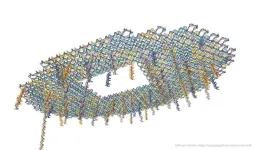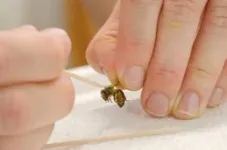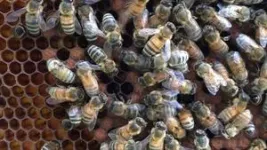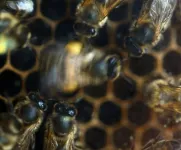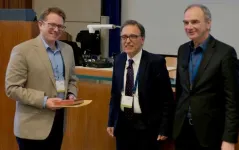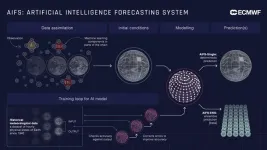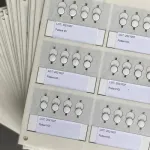(Press-News.org) Using an approach called DNA origami, scientists at Caltech have developed a technique that could lead to cheaper, reusable biomarker sensors for quickly detecting proteins in bodily fluids, eliminating the need to send samples out to lab centers for testing.
"Our work provides a proof-of-concept showing a path to a single-step method that could be used to identify and measure nucleic acids and proteins," says Paul Rothemund (BS '94), a visiting associate at Caltech in computing and mathematical sciences, and computation and neural systems.
A paper describing the work recently appeared in the journal Proceedings of the National Academy of Sciences. The lead authors of the paper are former Caltech postdoctoral scholar Byoung-jin Jeon and current graduate student Matteo M. Guareschi, who completed the work in Rothemund's lab.
In 2006, Rothemund published the first paper on DNA origami, a technique that provides simple yet exquisite control over the design of molecular structures at the nanoscale using nothing more than DNA.
Essentially DNA origami enables long strands of DNA to fold, through self-assembly, into any desired shape. (In the 2006 paper, Rothemund famously used the technique to create miniature DNA smiley faces measuring 100 nanometers across and 2 nanometers thick). Researchers begin with a long strand of DNA, the scaffold, in solution. Because the nucleotide bases that make up DNA bind in a known way (adenine binds to thymine, and guanine binds to cytosine), the scientists can add hundreds of short sequences of complementary DNA knowing they will bind to the scaffold on either end at known locations. Those short, added pieces of DNA fold the scaffold and give it shape, acting as "staples" that hold the structure together. The technique can then be used to create shapes ranging from a map of North and South America to nanoscale transistors.
In the new work, Rothemund and his colleagues used DNA origami to create a lilypad-like structure—a flat, circular surface about 100 nanometers in diameter, tethered by a DNA linker to a gold electrode. Both the lilypad and the electrode have short DNA strands available to bind with an analyte, a molecule of interest in solution—whether that be a molecule of DNA, a protein, or an antibody. When the analyte binds to those short strands, the lilypad gets pulled down to the gold surface, bringing 70 reporter molecules on the lilypad (which indicate that the targeted molecule is present) into contact with the gold surface. These reporters are redox reactive molecules, meaning they can easily lose electrons during a reaction. So, when they get sufficiently close to an electrode, an electric current can be observed. A stronger current indicates that more of the molecule of interest is present.
Previously, a similar approach to making biosensors was developed using a single DNA strand rather than a DNA origami structure. That earlier work was led by Kevin W. Plaxco (PhD '94) of UC Santa Barbara, who is also an author of the current paper.
Caltech's Guareschi points out that the new lilypad origami is large compared to a single DNA strand. "That means it can fit 70 reporters on a single molecule and keep them away from the surface before binding. Then when the analyte is bound and the lilypad reaches the electrode, there is a large signal gain, making the change easy to detect," Guareschi says.
The relatively large size of the lilypad origami also means that the system can readily accommodate and detect larger molecules, such as large proteins. In the new paper, the team showed that the two short DNA strands on the lilypad and the gold surface could be used as adapters, making it a sensor for proteins rather than for DNA. In the work, the researchers added the vitamin biotin to those short DNA strands to turn the system into a sensor for the protein streptavidin. Then they added a DNA aptamer, a DNA strand that can bind to a specific protein; in this case, they used an aptamer that binds to a protein called platelet-derived growth factor BB (PDGF-BB), which could be used to help diagnose diseases such as cirrhosis and inflammatory bowel disease.
"We just add these simple molecules to the system, and it's ready to sense something different," Guareschi says. "It's large enough to accommodate whatever you throw at it—that could be aptamers, nanobodies, fragments of antibodies—and it doesn't need to be completely redesigned every time."
The researchers also show that the sensor can be reused several times, with new adapters added each round for different detections. Although the performance slightly degrades over time, the current system could be reused at least four times.
In the future, the team hopes the system might also be useful for proteomics—studies that determine what proteins are in a sample and at what concentrations. "You could have multiple sensors at the same time with different analytes, and then you could do a wash, switch the analytes, and remeasure. And you could do that several times," Guareschi says. "Within a few hours, you could measure hundreds of proteins using a single system."
Additional authors of the paper, "Modular DNA origami-based electrochemical detection of DNA and proteins," are Jaimie M. Stewart of UCLA; Emily Wu and Ashwin Gopinath of MIT, Netzahualcóyotl Arroyo-Currás of Johns Hopkins University School of Medicine, Philippe Dauphin-Ducharme of the Université de Sherbrooke in Canada; and Philip S. Lukeman of St. John's University in New York.
The team used fabrication equipment at the Kavli Nanoscience Institute at Caltech. The work was supported by the Army Research Office, the Office of Naval Research, the National Science Foundation, and the Life Sciences Research Foundation supported by Merck Research Laboratories.
END
DNA origami suggests route to reusable, multifunctional biosensors
2025-02-25
ELSE PRESS RELEASES FROM THIS DATE:
Virginia Tech study reveals that honeybee dance ‘styles’ sway food foraging success
2025-02-25
As far as animals go, honeybees are world-class dancers.
While not as deep and complex as a Super Bowl half-time show, the bees' moves, known as the “waggle" dance, convey very specific food foraging instructions to their nestmates. The direction the dancer moves explains to other bees which way to go, and the duration of the waggle dance, or the “run,” shows how far to go. Once other bees have been convinced to follow the directions, they are “recruited.” After receiving the instructions, these ...
Beehive sensors offer hope in saving honeybee colonies
2025-02-25
A UC Riverside computer science team has developed a sensor-based technology that could revolutionize commercial beekeeping by reducing colony losses and lowering labor costs.
Called the Electronic Bee-Veterinarian, or EBV, the technology uses low-cost heat sensors and forecasting models to predict when hive temperatures may reach dangerous levels. The system provides remote beekeepers with early warnings, allowing them to take preventive action before their colonies collapse during extreme hot or cold weather or when the bees cannot regulate their hive temperature because of disease, pesticide exposure, food shortages, or other stressors. ...
Award-winning research may unlock universe’s origins
2025-02-25
University of Texas at Arlington physicist Ben Jones has received an international honor for his contributions to developing advanced instruments used in particle physics research.
Dr. Jones, an associate professor of physics, was awarded the 2025 International Committee for Future Accelerators (ICFA) Early Career Researcher Instrumentation Award. Presented by the ICFA Instrumentation Innovation and Development Panel, the award recognizes significant advancements in the innovation and development of new instrumentation for future accelerator experiments.
He accepted the award last week at the 2025 Vienna ...
BRCA1 gene mutations may not be key to prostate cancer initiation, as previously thought
2025-02-25
Mutations in the BRCA1 gene that are either inherited (germline) or acquired (somatic) might not be key to the initiation of prostate cancer, as previously thought, suggests the first study of its kind, published online in the open access journal BMJ Oncology.
If confirmed in further studies, the findings suggest that it may be time to reassess current treatment with PARP (poly(ADP-ribose) polymerase) inhibitor drugs, which block the ability of cells, including cancer cells, to repair DNA damage, in men with BRCA1 genetic variants, say the researchers.
A linked editorial suggests that the findings pave the way for greater refinement of genetic ...
Melatonin supplementation may help offset DNA damage linked to night shift work
2025-02-25
Melatonin supplementation may help offset the DNA damage associated with night shift work by boosting the body’s ability to repair it, suggest the findings of a small clinical trial published online in the journal Occupational & Environmental Medicine.
Larger studies looking at varying doses and the potential long term effects of melatonin supplementation are now warranted, conclude the researchers.
Normal night-time production of the body clock hormone, melatonin, is suppressed in night shift workers. This compromises the body’s ability to repair oxidative DNA damage, the by-product of normal cellular processes, heightening the risk of ...
Common gynaecological disorders linked to raised heart and cerebrovascular disease risk
2025-02-25
Having one or more common gynaecological disorders, such as endometriosis or heavy or irregular periods, may be linked to a heightened risk of heart disease and conditions that affect blood flow to the brain (cerebrovascular disease), finds a pooled data analysis of the available evidence published online in the journal Heart.
Although the quality of the studies included in the analysis was variable, the researchers nevertheless conclude that clinicians and the public need to be more aware of these associations to potentially mitigate the risks.
Long term non-cancerous gynaecological disorders ...
Nerve fibers in the inner ear adjust sound levels and help compensate for hearing loss in mice, study finds
2025-02-25
The brain may play a role in helping the ear regulate its sensitivity to sound and compensate for hearing loss by sending a signal to a structure in the inner ear known as the cochlea, according to a study that was just published in the Journal of Neuroscience. The discovery could help researchers develop treatments for tough-to-treat hearing disorders such as hyperacusis, where everyday sounds seem uncomfortably loud, and tinnitus, a sensation of ringing, buzzing or other sound in the ear when there is no external source.
The findings were powered by a new ...
ECMWF – Europe’s leading centre for weather prediction makes forecast data from AI model available to all
2025-02-25
Embargo: 25 February 2025 00.01 AM GMT
ECMWF – Europe’s leading centre for weather prediction makes forecast data from AI model available to all
A newly operational model, known as the Artificial Intelligence Forecasting System (AIFS), has been launched by the European Centre for Medium-Range Weather Forecasts (ECMWF), an intergovernmental centre and leader in numerical weather prediction. For many measures including tropical cyclone tracks, the AIFS outperforms state-of-the-art physics-based models, with gains ...
New paper-based device boosts HIV test accuracy from dried blood samples
2025-02-24
In parts of the world where traveling to a clinic for routine blood tests is a financial and logistical challenge, HIV patients increasingly have the option to collect and ship a drop of their blood in paper-based devices that absorb the sample and store it for analysis in far-away labs.
While this technology is helpful for tracking someone’s adherence to their drug regimen or monitoring disease progression, the most frequently used devices don’t control how much blood they collect, potentially leading to inaccurate readings of a person’s infection.
Understanding this limitation, Charlie Mace, an associate professor at Tufts University’s ...
Pay-for-performance metrics must be more impactful and physician-controlled
2025-02-24
Pay-for-Performance Metrics Must Be More Impactful and Physician-Controlled
Background: This editorial builds on a study by Brulin and Teoh, released ahead of the March/April 2025 issue of Annals of Family Medicine, which found that performance-based reimbursement is associated with lower perceived quality of care by increasing illegitimate tasks and moral distress for primary care physicians.
Editorial Stance: Quality metrics and pay-for-performance initiatives are far more expensive than many patients, clinicians, or administrators realize. The authors call for more rigorous review through cluster randomized controlled trials both before and after implementation—and ...
